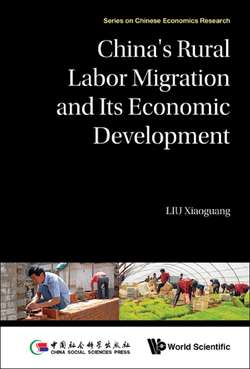Читать книгу China's Rural Labor Migration and Its Economic Development - Xiaoguang Liu - Страница 31
На сайте Литреса книга снята с продажи.
2. The results of the empirical analysis
ОглавлениеWith the use of the panel data of China’s provinces and regions, the transfer of agricultural labor has been used as an explained variable to analyze the determinants of the transfer of agricultural labor. By reference to the practices in the previous literature, both SAR and SEM models are used for analysis in this section to overcome the influence of a potential spatial correlation and to carry out a maximum likelihood estimation. The same is true also for the setting of the spatial weight matrix. The weight coefficient of adjacent provinces is set as 1, and the weight coefficient of non-adjacent provinces is set as 0.25 The weight matrix is standardized in the estimation of the specific measurement. For comparison purposes, the regression results under the two models are reported symmetrically in the regression table.
Table 2.2 shows the results of the baseline regression, indicating that the variable of the urban–rural income gap is significantly positive. This means that a larger urban–rural income gap leads to a stronger motivation for the transfer of agricultural labor and the greater transfer volume of agricultural labor, which is in line with the expectations. The coefficient of the growth rate of the GDP is significantly positive, indicating that economic growth increases the demand for non-agricultural labor, which is conducive to promoting the transfer of agricultural labor. The coefficient of the level of the scale of infrastructure is significantly positive, indicating that the improvement of the level of infrastructures is conducive to reducing labor transfer costs and promoting the transfer of agricultural labor, which is consistent with the expectations.
The estimated results of other influencing variables are also roughly in line with the expectations. The coefficient of the proportion of state-owned enterprises is significantly negative, indicating that the larger the proportion of state-owned enterprises is the smaller the volume of labor transfer will be. The possible explanation is that the restriction of the household registration system may make it difficult for the agricultural labor to become the staff of state-owned enterprises, and thus, the agricultural labor mainly flows to the non-state-owned enterprises, leading to an increase in the proportion of state-owned enterprises. This indicates that the increased power of monopoly of state-owned enterprises may weaken the transfer of labor. The coefficient of the level of public education expenditure is significantly negative, indicating that the increase in the level of public education expenditure is not conducive to the rapid transfer and employment of agricultural labor. As a result, the biased expenditure of public education further reduces the employment opportunities for agricultural labor to cities in reality. Similarly, the current biased financial development is also not favorable for promoting the transfer of agricultural labor, and the improvement of financial efficiency plays a positive role to some extent. The improvement of agricultural labor productivity represented by the level of agricultural mechanization has a significant negative impact on the transfer of agricultural labor. This is possibly because of the fact that the opportunity costs of the transfer of agricultural labor increase with the increase in the output of agricultural products and agricultural labor income. In addition, the coefficient of capital return is significantly positive, indicating that the higher rate of capital return leads to greater investment incentives and a higher demand for non-agricultural labor, which is more favorable for promoting the transfer of agricultural labor.
Table 2.2. Baseline Regression Results of the Driving Factors of the Transfer of Agricultural Labor.
Note: *, **, and *** indicate statistical significance at 10%, 5%, and 1% levels, respectively. Moran’s I is the result of the spatial correlation test. The coefficients ρ and λ are the spatial correlation coefficients of the SAR and the SEM, respectively. R2, adjusted R2 and log-likelihood reflect the goodness of the fit of the model.
The regression coefficient of the total factor productivity variable is significantly negative, indicating that the transfer of labor is weakened with the improvement of the level of technology. It is possibly because of the fact that the influence of total factor productivity on promoting the transfer of labor by output increase has been controlled by the variable of the growth rate of the GDP, the remaining influence shows that the technological progress is biased. The increase in the proportion of technologyintensive enterprises and capital-intensive enterprises reduces the demand for the transfer of agricultural labor, which is not conducive to promoting the transfer of agricultural labor. In addition, the FDI/GDP ratio also has a significant negative impact on the transfer of agricultural labor. This is possibly because of the fact that it is difficult for foreign enterprises to promote the transfer of agricultural labor due to higher requirements on human capital. However, the specific reasons still need to be further studied. Other variables such as CPI and the coefficient of the rate of registered urban unemployment are not significant, indicating that there may be no significant impact on the transfer of labor. However, the insignificant coefficient of the rate of registered urban unemployment may also be caused by the defects in the existing indicator of the rate of unemployment. However, the data from urban household surveys have been used to estimate the rate of surveyed urban unemployment in the nine provinces, and the results of the regression analysis are not significantly different (for the specific results, refer to Exhibit 1 of Appendix B).
